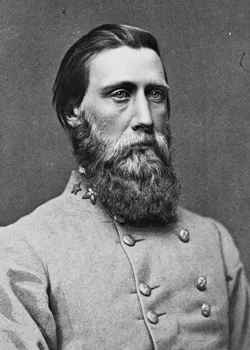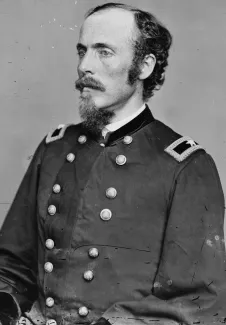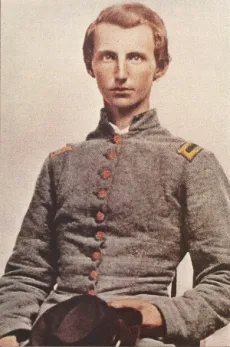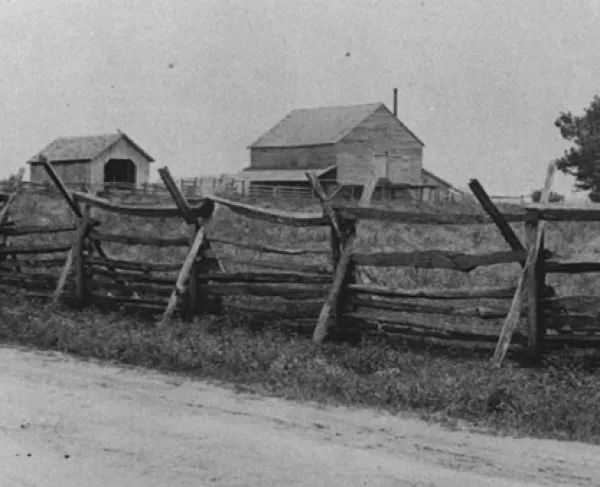10 Facts: The Battle of Franklin

Learn more about the Battle of Franklin, one of the fiercest battles of the Civil War. Our Ten Facts page will help expand your appreciation for this 1864 battle in Tennessee
Fact #1: John Bell Hood sought to defeat John Schofield’s Union force at Franklin before they could unite with fresh troops around Nashville.

After taking Atlanta, Union general William Sherman turned east in his “March to the Sea.” In response, Confederate general John Bell Hood led the Army of Tennessee north out of Georgia and towards the supply and communications hub of Nashville, Tennessee, aiming to draw Sherman into a fruitless pursuit before swinging through Kentucky and joining Robert E. Lee in Virginia with a legion of new recruits and cartloads full of Yankee food and munitions. General John Schofield, commanding Sherman’s rearguard, parried Hood’s thrusts in a series of small engagements as both forces raced towards Nashville. Hood’s hopes for a decisive campaign lay on defeating Schofield before the Union general reached the city, where another 25,000 Federals under General George Thomas waited. Hood caught Schofield at Franklin on November 30, 1864, about twenty miles south of Nashville. As the sun began to set, Hood ordered an attack.
Fact #2: Missed opportunities at Spring Hill played a significant role in the Battle of Franklin.
On November 29, John Schofield was trapped. At Columbia, Tennessee, he had prevented Hood from crossing the Duck River for five days. When Confederates began to assemble for battle on the southern bank of the Duck on the 29th, Schofield felt it was time to withdraw. He sent half of his army twelve miles north to Spring Hill while the other half remained to cover the river crossing. But Schofield had been fooled—the grey mass opposite Columbia was a diversion. While their comrades occupied Schofield’s attention, two Confederate divisions crossed at a ford further east and swung around the city to land astride the north-south road connecting Columbia to Spring Hill. The Union force was divided and in grave danger. To Hood’s fury, however, Schofield still managed to escape. Command confusion disrupted several Confederate attacks in what became known as the Battle of Spring Hill, preventing a decisive interdiction of the Federal escape route. That night, soldiers and wagons evacuating Columbia passed within earshot of the Confederates encamped along the road, but the attack that might have changed the course of the campaign never came. The next day, Hood, “wrathy as a rattlesnake,” accused the Army of Tennessee of cowardice and ordered a pursuit to Franklin. The failure of the day before had prevented a battle to the Southerners’ advantage and sealed the violent fate of thousands.
Fact #3: The Confederate charge at Franklin was larger, longer, and deadlier than Pickett’s Charge at Gettysburg.
The Army of Tennessee arrived on the Franklin battlefield from the south, in the shadow of Winstead Hill. Schofield had drawn his army up into a three-tiered series of hastily-constructed but formidable breastworks on the outskirts of town, roughly two miles north of the unfolding grey battle line. Over the protests of his lieutenants, Hood ordered a frontal assault on the Federal works. Several elements of the ensuing battle are worthy of comparison with Lee’s assault on July 3, 1863. At Gettysburg, 12,000 Confederates attacked over a mile of open ground following a 150-gun bombardment of a Union line protected by a low stone wall. They reached their objective and held out for around thirty minutes before being repulsed, leaving about 1,415 dead or mortally wounded on both sides. At Franklin, 20,000 Confederates, supported by just one battery, advanced over two miles of open ground and struck a Union line made up of three tiers of sturdy breastworks and abatis that in most places stood about eight feet high. The Army of Tennessee pierced the center of this line and held their position for over three hours, resulting in over 2,000 combined fatalities. Such bravery and ferocity so late in the war shocked and saddened many observers--Private Sam Watkins of the 1st Tennessee called it "the blackest page in the history of the war."
Fact #4: The first line of the Union defense at Franklin actually helped the Confederates.
The main Union line at Franklin ran in a rough crescent around the town, both of its flanks secured on the Harpeth River. Two brigades of George Wagner’s division held advanced positions to the south, squarely in the path of John Bell Hood’s assault. The butternut advance quickly proved that Wagner’s decision to move into the field between the two armies was a grave mistake. With a cry of “into the works with them!” the Confederate line overlapped and overwhelmed Wagner’s men. The Union defenders stampeded back towards the main line after firing a single volley, the charging Southerners hot on their heels. Afraid of hitting their comrades, the riflemen on the main line held their fire as they watched the intermingled crowd of butternut and blue surge towards them. As a result, the last half-mile of the Confederate advance was largely uncontested, allowing the charge to hit the main line with full force.
Fact #5: Union general Emerson Opdycke saved the center by disobeying orders.

Emerson Opdycke led a brigade in George Wagner’s division. As the Confederates approached, Wagner ordered Opdycke to join his fellow brigade commanders, John Lane and Joseph Conrad, in a line thrown out half a mile in front of the Union breastworks. Recognizing the folly of taking such exposed position in front of a vastly superior force, Opdycke vehemently refused to obey Wagner’s directive and instead deployed his brigade about two hundred yards behind the Carter House. Although he was mainly looking for a good place to cook breakfast, from this spot he could also quickly reinforce any threatened point in the Union center. When Wagner’s position was shattered and his men were hurled back through the main line, the Confederate attackers secured a dangerous foothold in the maelstrom around the Carter House. Opdycke threw his men into the fray. The Confederates could advance no further, and after hours of bloody combat the line was finally stabilized. Had Opdycke obeyed Wagner’s orders, his command would have surely been routed along with the rest of the division and Hood’s army may well have shattered the unsupported main line.
Fact #6: The course of World War II could have been greatly altered at the Battle of Franklin.
Arthur MacArthur, Jr., “The Boy Colonel,” was a novelty in the Union Army. He had enlisted in the 24th Wisconsin Infantry regiment underage at the beginning of the war, but had already made an impressive name for himself. At the Battle of Missionary Ridge on November 25, 1863, as an eighteen year-old first lieutenant, MacArthur had seized the regimental colors from a decapitated comrade and led the charge that broke a seemingly unbreakable line. He was awarded the Medal of Honor and promoted to colonel. At Franklin, now leading the 24th Wisconsin of Opdycke’s brigade in the middle of the reserve line, MacArthur and his men, with a shout of “Up, Wisconsin!” plunged into the melee at the Carter House after the initial Confederate charge splintered the Union defenses. MacArthur was shot off of his horse almost immediately. Bleeding from the shoulder, he drew his saber and began cutting his way through the melee towards a ragged Southern flag waving above the fray, under which MacArthur came face-to-face with a Confederate officer. The Southerner leveled his pistol and shot MacArthur in the chest. MacArthur kept his feet and ran his opponent through, but the falling officer fired once more and hit MacArthur in the leg. Gravely wounded, MacArthur was nearly trampled before his men dragged him to safety. Miraculously, the young colonel survived his wounds and the war. His son Douglas became one of the United States’ top generals in World War II and Korea. To this day, Arthur and Douglas are the only father and son pair besides Theodore Roosevelt and Theodore Roosevelt, Jr. to have won the Medal of Honor.
Fact #7: Franklin resident Tod Carter was mortally wounded five hundred feet from his boyhood home.

When the Army of Tennessee crossed the Georgia-Tennessee border, the soldiers were heartened by a sign on the side of the road that read “Tennessee, A Grave or A Free Home.” Those words must have had special meaning for Tod Carter, the middle child in the Carter family, who had enlisted in the Confederate army in 1861. By 1864, he was the assistant quartermaster to Brigadier General Thomas Benton Smith in the Army of Tennessee. On the eve of the Battle of Franklin, a friend described Carter as “in a perfect ecstasy of joy” to be seeing his family the next day. As part of Bates’s division, Smith’s brigade launched their attack at Franklin from the far left of the Confederate line. Although Tod Carter’s quartermaster duties did not require him to fight, he would not hear of it. He mounted his horse and rode ahead of the brigade, shouting “Follow me boys, I’m almost home!” About five hundred feet from his front yard, Tod Carter was struck by a Union bullet and tumbled into the blood-soaked grass. After the day’s carnage had ended, the Carter family emerged from their cellar only to be greeted by General Smith with the news of Tod’s wounding. By lantern-light, Smith and the Carters spent hours searching the corpse-strewn battlefield for the young captain. His sisters’ screams announced to the party that the search was over. Dying and insensible, Tod was carried back to the Carter House near dawn and set down in his sister Annie’s room. He died the next day, just one of the nearly ten thousand family tragedies that the battle wrought.
Fact #8: More Confederate generals were killed at Franklin than in any other battle in the war.
Patrick Cleburne, John Carter, John Adams, Hiram Granbury, States Rights Gist, and Otho Strahl were all killed leading their men in the assault on the Union breastworks at Franklin. Adams was found upright in his saddle, riddled with bullets, with his horse’s legs on either side of the works. Cleburne vanished in a cloud of gun smoke and was found with a bullet in his heart. In comparison, five Confederate generals were killed at Gettysburg, three were killed at Antietam, three at Chickamauga, and two at Spotsylvania. John Brown, Francis Cockrell, Zachariah Deas, Arthur Manigault, Thomas Scott, and Jacob Sharp were also wounded and George Gordon was captured at Franklin. Perhaps spurred to greater danger by John Bell Hood’s accusation of cowardice in the ranks on the morning of the battle, no other engagement of the war saw as much devastation in the Confederate general officer corps as did the Battle of Franklin.
Fact #9: The Battle of Franklin nearly ruined the Army of Tennessee.
After the battle, Schofield resumed his withdrawal towards Nashville, now decisively ahead of the Confederate army. Hood continued to pursue, although his army had been devastated at Franklin and stood no chance of defeating a united Federal force. At the Battle of Nashville, fought from December 15-16, 1864, the reinforced Union army left its fortifications and brought Hood to battle, routing the Army of Tennessee once and for all. It would never fight again as a cohesive force. Hood’s unwillingness to withdraw during the Battle of Nashville compelled Schofield to comment that “I doubt if any soldiers in the world ever needed more cumulative evidence to convince them that they were beaten.”
Fact #10: Preservation of the Franklin battlefield is one of the Civil War Trust’s greatest success stories, but much work remains to be done.
Despite the importance of the Battle of Franklin, for many years the land’s legacy was all but ignored as the city grew in the years following the war. Save for a small tract preserving the Carter House, Franklin was the scene of many disturbing developments, including a Pizza Hut parking lot and a strip mall on top of the site of some of the day’s bloodiest fighting near the Carter Cotton Gin. However, the efforts of the Civil War Trust, with the help of local partners that include Franklin’s Charge, Save the Franklin Battlefield, Inc., the Battle of Franklin Trust, and the City of Franklin, have produced stirring results. Today, well over a hundred acres of battlefield land have been reclaimed and preserved, often one acre at a time over a span of many years. In 2005, the Pizza Hut property was bought and restored to its 1864 appearance. In 2012, the Civil War Trust and its partners secured the strip mall, another acre and a half, and thus scored another major victory in the historic journey to reclaim the heart of a battlefield that was once considered lost forever.
Learn More: War in the West
Related Battles
2,326
6,252





